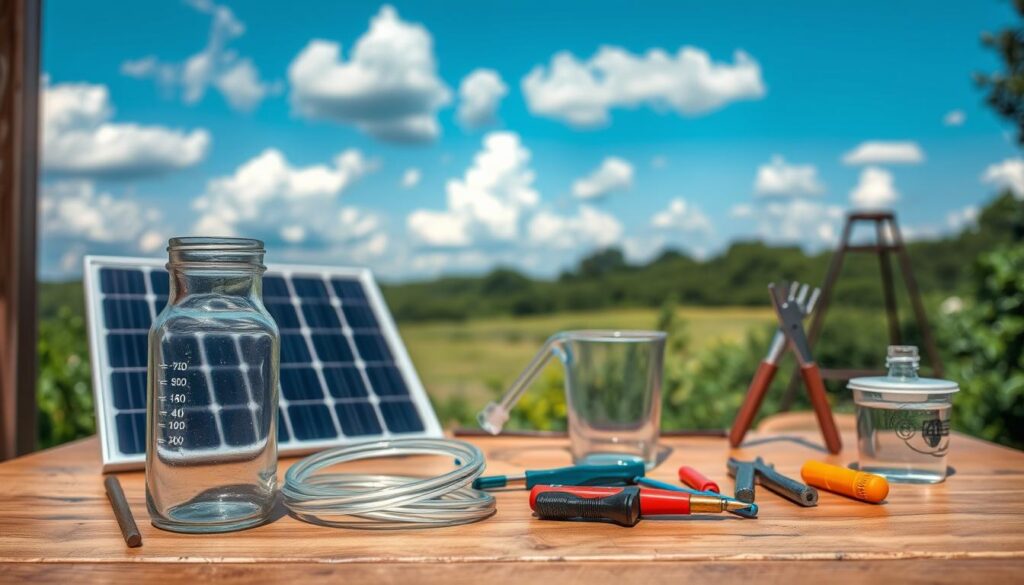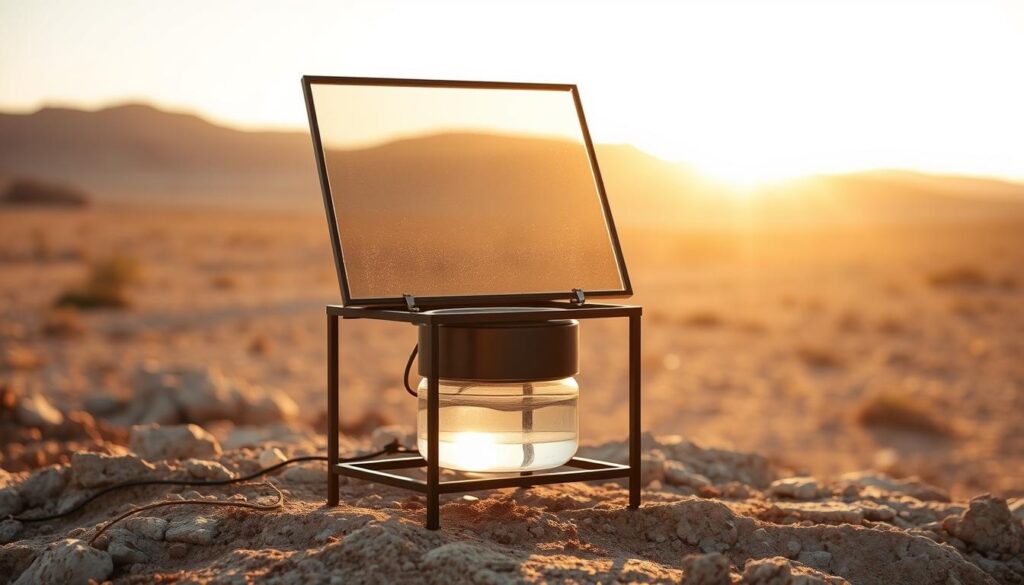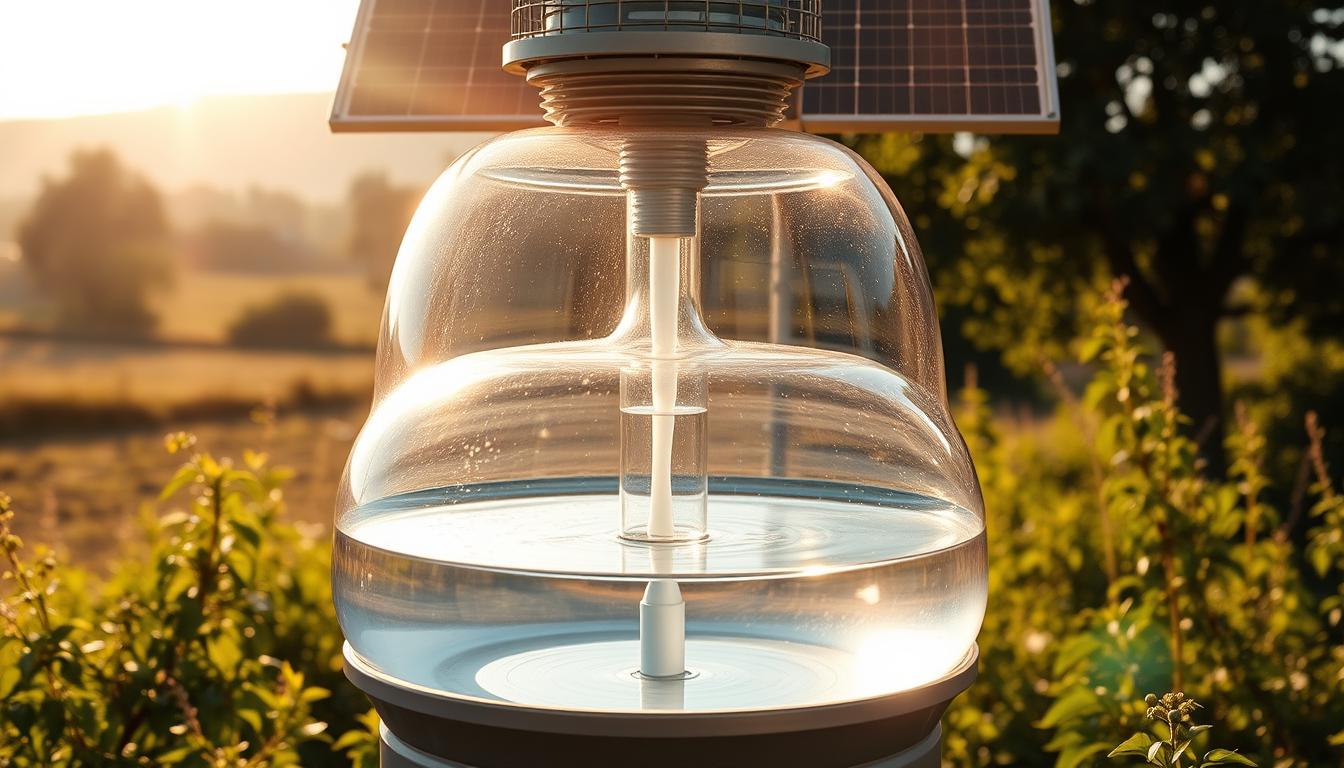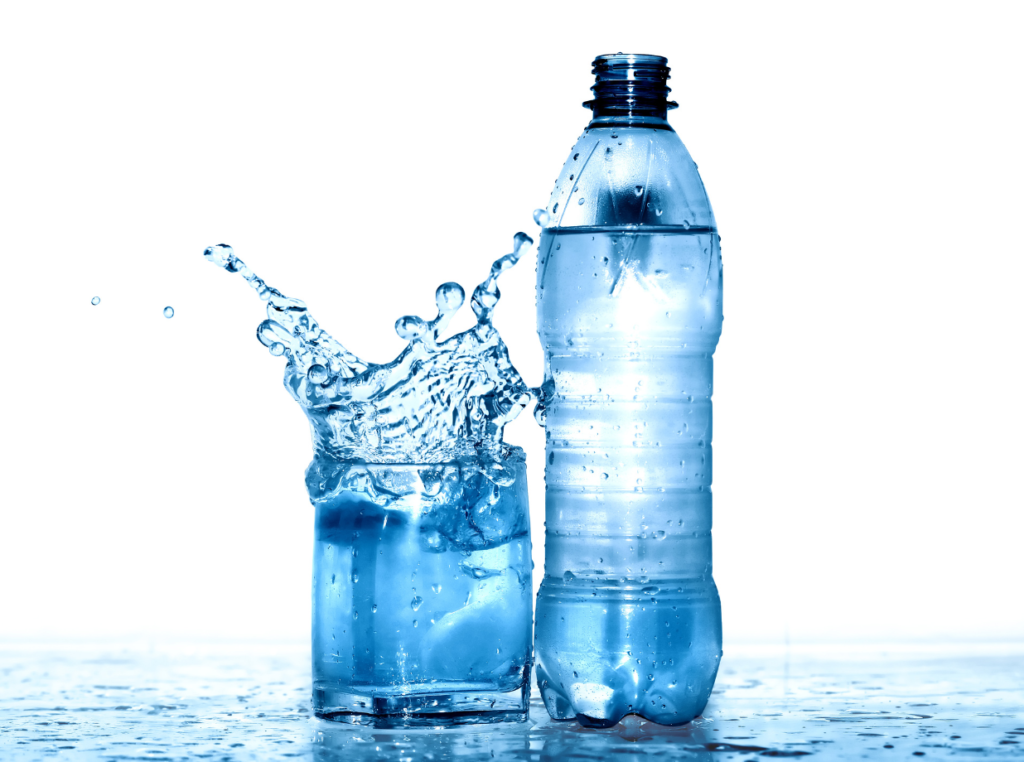Can you imagine having access to clean drinking water anywhere, anytime, without relying on complex equipment or municipal supplies?
This is not just a dream; it’s a reality with a Solar Distillation System. In areas where water is scarce or contaminated, a DIY Solar Water Distiller can be a lifesaver, providing a simple, effective, and sustainable way to purify water using the power of the sun.
A Solar Distillation System works by evaporating water and then condensing it, leaving impurities behind. This method is not only effective but also environmentally friendly, making it an attractive Off-Grid Purification Solution for those in need.
Key Takeaways
- Understanding the basics of a DIY Solar Water Distiller.
- Learning how solar distillation works for water purification.
- Discovering the benefits of using a Solar Distillation System.
- Exploring the potential of Off-Grid Purification Solutions.
- Identifying the simplicity and effectiveness of DIY solar water distillation.
The Science of Solar Water Distillation
By harnessing the energy from the sun, solar water distillation provides a sustainable solution for clean drinking water. This process is both simple and effective, making it an ideal method for off-grid water purification.
Understanding the Evaporation-Condensation Process
The evaporation-condensation process is the heart of solar water distillation. It involves two main steps: first, the sun’s heat evaporates the water from a contaminated source; second, the water vapor condenses on a surface, free from many contaminants.
How Sunlight Converts Contaminated Water to Pure Water
Sunlight plays a crucial role in solar distillation. As sunlight enters the distiller, it heats the water, causing it to evaporate. The vapor then rises and condenses on a cooler surface, resulting in pure water. This process effectively removes various impurities, including salts, heavy metals, and bacteria.
Types of Impurities Removed Through Distillation
Solar water distillation is effective in removing a wide range of impurities. The following table summarizes some common contaminants that are removed through this process:
| Contaminant Type | Examples | Removal Effectiveness |
|---|---|---|
| Salts and Minerals | Sodium, Calcium, Iron | High |
| Heavy Metals | Lead, Mercury, Arsenic | High |
| Bacteria and Viruses | E. coli, Salmonella, Rotavirus | Very High |
In conclusion, solar water distillation is a reliable and sustainable method for purifying water. By understanding the science behind this process, individuals can appreciate its value in providing clean drinking water, especially in off-grid or emergency situations.
Benefits of Solar Water Distillers for Off-Grid Living
Embracing off-grid living means finding innovative ways to purify water, and solar distillers are leading the way. Solar water distillers provide a multitude of benefits for those living off the grid, from reducing environmental impact to ensuring a steady supply of clean water.
Zero Energy Costs and Environmental Impact
One of the most significant advantages of solar water distillers is their ability to operate with zero energy costs. By harnessing the power of the sun, these systems eliminate the need for electricity or fuel, reducing both your carbon footprint and operational expenses. This eco-friendly approach to water purification is not only cost-effective but also contributes to a more sustainable lifestyle.
Independence from Municipal Water Systems
Solar water distillers offer independence from municipal water systems, allowing individuals to purify their own water on-site. This is particularly beneficial for those living in remote areas where access to clean water is limited. By having control over your own water purification, you are less vulnerable to municipal water supply disruptions.
Disaster Preparedness and Emergency Water Supply
In times of natural disasters or emergencies, having a reliable source of clean water is crucial. Solar water distillers can provide a steady emergency water supply, ensuring that you and your family have access to clean drinking water even when traditional water supplies are compromised. The key benefits include:
- Reliable source of clean drinking water
- Independence from potentially contaminated municipal supplies
- Ability to purify water from any source (e.g., rivers, lakes, rainwater)
By investing in a solar water distiller, individuals can enjoy a sustainable, cost-effective, and reliable means of obtaining clean water, making it an invaluable asset for off-grid living.
Comparing Solar Distillation to Other Purification Methods
The quest for clean drinking water has led to the development of various purification methods, including solar distillation, filtration systems, and chemical treatment. Understanding the differences between these methods is crucial for selecting the most appropriate solution for off-grid living.
Solar Distillation vs. Filtration Systems
Solar distillation and filtration systems are two distinct approaches to water purification. While filtration systems physically remove contaminants from water, solar distillation uses the sun’s heat to evaporate water, leaving impurities behind. Solar distillation is particularly effective against a wide range of contaminants, including salts and heavy metals, making it a reliable method for producing clean drinking water.
Advantages Over Chemical Treatment Methods
Chemical treatment methods involve adding substances to water to remove or neutralize contaminants. However, these methods can leave behind chemical residues and may not remove all impurities. In contrast, solar distillation is a chemical-free process that relies on natural evaporation and condensation, ensuring that the purified water is free from chemical additives.
Cost Analysis: DIY Solar vs. Commercial Purifiers
When considering the cost, DIY solar water distillers offer a cost-effective solution compared to commercial water purifiers. The initial investment for a DIY solar distiller can be significantly lower, and since it uses solar energy, there are no ongoing energy costs. A cost analysis reveals that while commercial purifiers may offer convenience, DIY solar distillers provide a sustainable and economical alternative for off-grid water purification.
In conclusion, solar distillation stands out as a reliable and cost-effective method for water purification, especially for those living off-grid. By comparing it with other purification methods, individuals can make informed decisions about their water treatment needs.
Essential Materials and Tools for Your DIY Solar Water Distiller
Before starting your DIY solar water distiller project, it’s essential to understand the necessary materials and tools required. A well-prepared builder can ensure the distiller’s efficiency and longevity.
Core Materials Shopping List with Estimated Costs
The core materials needed for a basic DIY solar water distiller include:
- A shallow container or basin (e.g., a plastic tub) – $10-$20
- A smaller container to collect distilled water – $5-$10
- A clear plastic or glass cover – $5-$15
- Tubing or piping for water collection – $5-$10
- Sealant (e.g., silicone) to prevent leaks – $5-$10
The total estimated cost for these materials can range from $25 to $65, depending on the specific items and sources chosen.

Required Tools and Safety Equipment
To assemble and maintain your solar water distiller, you’ll need the following tools and safety equipment:
- Drill and bits for making holes for tubing
- Utility knife or scissors for cutting materials
- Gloves to protect your hands from sharp edges and contaminants
- Safety goggles to protect your eyes during drilling and other operations
Using the right tools and safety equipment can significantly enhance the safety and efficiency of your DIY project.
Sourcing Recycled Materials to Reduce Costs
One of the advantages of a DIY solar water distiller is the potential to use recycled materials, reducing both costs and environmental impact. Consider the following sources:
- Old plastic containers or tubs that can serve as the basin
- Unused glass or plastic sheets for the cover
- Discarded tubing or piping for water collection
By sourcing recycled materials, you can not only save money but also contribute to reducing waste.
How to Build a DIY Solar Water Distiller (Off-Grid Solution)
With a few simple materials, you can construct a solar water distiller that meets your off-grid water needs. The process involves several key steps, from designing your distiller to collecting purified water.
Designing Your Distiller Based on Water Needs
The first step in building your DIY solar water distiller is to determine your water needs. Consider the number of people you need to supply water for and the average amount of water each person requires daily. A typical solar distiller can produce between 1-2 liters of clean water per day, depending on sunlight conditions.
When designing your distiller, keep in mind the space available for the unit and the materials you have on hand. A compact design is ideal for small spaces or mobile applications.
Constructing the Basin and Water Container
The basin is a critical component of your solar distiller, as it holds the contaminated water. To construct the basin:
- Choose a shallow, wide container to maximize the surface area exposed to sunlight.
- Ensure the container is watertight to prevent leakage.
- Use a dark-colored container or paint it black to absorb more heat.
Creating the Condensation Surface
The condensation surface is where the magic happens, turning water vapor back into liquid. To create an effective condensation surface:
- Use a clear plastic sheet or glass that allows sunlight to pass through.
- Angle the condensation surface to allow condensed water to run off into the collection system.
- Ensure the surface is clean and free of contaminants to maximize efficiency.
Building the Collection System for Purified Water
The collection system gathers the purified water that condenses on the underside of the plastic or glass cover. To build an effective collection system:
- Position a collection trough or channel under the lowest point of the angled condensation surface.
- Use a tube or pipe to direct the purified water from the trough to a storage container.
- Ensure all components are clean and securely attached to prevent contamination.
Here’s a simple comparison of different materials you can use for your solar distiller:
| Material | Cost | Durability |
|---|---|---|
| Plastic Container | Low | Medium |
| Glass Container | Medium | High |
| Metal Basin | High | High |
By following these steps and considering your specific needs, you can build an effective DIY solar water distiller that provides a reliable source of clean drinking water off-grid.
Step-by-Step Assembly Process
Assembling your solar water distiller involves several key steps that ensure its efficiency and durability. This process is crucial for the effective operation of your off-grid water purification system.
Preparing and Sealing the Base Container
The first step is to prepare the base container that will hold the contaminated water. Ensure it’s clean and free from any contaminants. Apply a sealant around the edges to prevent leaks. Let the sealant dry completely before proceeding.
Installing the Angled Glass or Plastic Cover
Next, install the angled glass or plastic cover on top of the base container. This cover should be angled to allow the condensed water to trickle down into the collection trough. Ensure the cover is tightly sealed to prevent any external contaminants from entering the system.
Setting Up the Collection Trough and Output Tube
The collection trough is where the purified water will be collected. Attach the output tube to the trough, ensuring it’s directed into a clean container. Secure the tube firmly to prevent it from coming loose during operation.
Weatherproofing Your Completed Distiller
Finally, weatherproof your completed distiller to protect it from the elements. Use a durable, waterproof coating on the exterior and ensure all seals are tight. This step is crucial for the longevity and effectiveness of your solar water distiller.
By following these steps, you’ll have a functional DIY solar water distiller that’s ready for use. Regular maintenance will ensure it continues to provide clean drinking water.
- Ensure all components are securely attached.
- Check for leaks and sealants regularly.
- Keep the distiller clean and free from debris.
Testing and Optimizing Your Solar Water Distiller
After assembling your DIY solar water distiller, it’s crucial to test its performance and optimize it for maximum efficiency. This process ensures that your distiller is working correctly and producing clean, safe drinking water.
First Run Procedures and Safety Checks
Before using your solar water distiller for drinking water, perform a test run with non-potable water to check for any leaks or issues. Inspect the distiller for any signs of damage or wear, and ensure all connections are secure. It’s also essential to clean the distiller thoroughly before the first use.
Measuring Daily Water Output
Monitor the daily water output to understand the distiller’s efficiency. Factors such as sunlight intensity, ambient temperature, and the distiller’s design can affect output. Record your observations to identify patterns and make necessary adjustments.
Testing Water Purity with Home Test Kits
Use home water test kits to check the purity of the distilled water. These kits can detect various contaminants, including bacteria, viruses, and heavy metals. Regular testing ensures the distiller is functioning correctly and producing safe drinking water.
Troubleshooting Common Performance Issues
Common issues with solar water distillers include low water output, contamination, and leakage. To troubleshoot:
- Check for obstructions or dirt on the condensation surface.
- Ensure the distiller is properly sealed to prevent leakage.
- Verify that the collection system is correctly aligned and functioning.
By addressing these issues, you can significantly improve your distiller’s performance and water quality.
Alternative Design Variations for Different Needs
The versatility of solar distillation allows for a range of design adaptations, making it suitable for various applications and environments. This flexibility is one of the key advantages of solar water distillation systems.
Compact Portable Solar Still for Camping
For outdoor enthusiasts, a compact and portable solar still is an ideal solution. These designs are typically lightweight and can be easily set up at a campsite. Portability is key here, with some models folding up into a small package. They are perfect for emergency kits or temporary water purification needs.

Large-Scale Fixed Installation for Homesteads
In contrast, homesteads or rural areas can benefit from larger, fixed solar distiller installations. These can be designed to provide a significant portion of a household’s clean water needs. Scalability is an important factor, allowing homeowners to adjust the size based on their water requirements.
Multi-Basin Design for Increased Efficiency
Some advanced designs incorporate multiple basins to increase the efficiency of the distillation process. This multi-basin approach can significantly boost water production, making it suitable for larger families or even small communities.
Greenhouse-Integrated Water Distillation Systems
Integrating solar distillation into greenhouses offers a dual benefit: clean water and a controlled environment for growing plants. This greenhouse-integrated system can be particularly useful in arid regions, maximizing water usage and crop yield.
| Design Type | Application | Key Features |
|---|---|---|
| Compact Portable | Camping, Emergency Kits | Lightweight, Easy Setup |
| Large-Scale Fixed | Homesteads, Rural Areas | Scalable, High Capacity |
| Multi-Basin | High Demand Areas | Increased Efficiency, Higher Yield |
| Greenhouse-Integrated | Agricultural Settings | Dual Purpose, Water & Crop Production |
These alternative designs highlight the adaptability and potential of solar water distillation systems, catering to a wide range of needs and applications.
Maintaining and Extending Your Distiller’s Lifespan
Regular upkeep of your solar water distiller can significantly extend its lifespan and ensure it continues to provide clean drinking water. Proper maintenance involves a combination of regular checks, preventive measures, and timely replacements of worn-out parts.
Weekly and Monthly Maintenance Schedule
To keep your distiller running smoothly, it’s essential to establish a routine maintenance schedule. Weekly checks should include inspecting the distiller for any signs of leakage, ensuring the collection system is clear, and verifying that the distiller is properly aligned with the sun. Monthly tasks involve a more thorough inspection, including cleaning the glass or plastic cover, checking for mineral buildup, and ensuring all connections are secure.
Preventing Mineral Buildup and Contamination
Mineral buildup is a common issue in solar water distillers, particularly in areas with hard water. To prevent this, regularly clean the basin and collection system. Using a mixture of vinegar and water can help dissolve mineral deposits. Additionally, ensure that the water input is free from contaminants to prevent the distiller from becoming a breeding ground for bacteria and algae.
Winterizing Your Solar Distiller
In colder climates, it’s crucial to winterize your solar distiller to prevent damage from freezing temperatures. This involves draining the system, storing removable parts in a warm location, and protecting the distiller from snow and ice. Consider using a freeze-proof distiller design or covering the distiller with insulation during the winter months.
When and How to Replace Key Components
Over time, certain components of your solar water distiller may need to be replaced. This includes the glass or plastic cover if it becomes scratched or cracked, and the collection tubing if it shows signs of wear. Regularly inspect these components and replace them as needed to maintain the distiller’s efficiency.
Conclusion
Having access to clean drinking water is essential, especially in off-grid situations. A DIY solar water distiller offers an effective and sustainable solution for purifying water using the power of the sun.
By building your own solar distiller, you can enjoy zero energy costs and independence from municipal water systems. This off-grid water purification method is not only environmentally friendly but also cost-effective.
With the knowledge gained from this article, you can now design and build a solar distiller tailored to your specific needs. Whether you’re a camper, homesteader, or prepper, a DIY solar water distiller is a valuable tool for ensuring a reliable source of clean drinking water.
Take the first step towards achieving off-grid water purification by starting your DIY solar water distiller project today.



